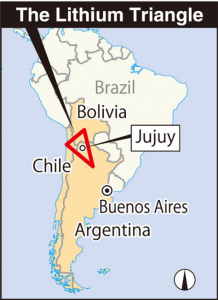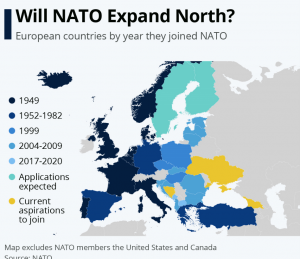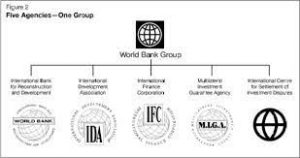THE WORLD GEOGRAPHY: NATURAL RESOURCES
NIGERIA’S LATEST LITHIUM RESOURCE
THE CONTEXT: Recently, high-grade lithium has been discovered in Nigeria. In 2019 the total production volume of lithium, not high grade, in Nigeria reached 50 metric tonnes This is small compared to Zimbabwe which produced 1,200 metric tonnes the same year.
THE EXPLANATION:
What is lithium and why is it important?
- The Geological Agency described the lithium as a high grade because what’s been found has between 1-13 per cent oxide content. Normally exploration begins at levels as low as 0.4 per cent.
- Grade (in per cent) is a measure of the concentration of the lithium in the minerals and or rocks that contains it. Therefore, the higher the grade the more the economic viability. Higher grades are very rare for metals like lithium.
- Lithium is a metallic mineral in very high demand by manufacturing industries. Seven years ago the bulk of demand for lithium was split between ceramics and glasses (35 per cent) and greases, metallurgical powders, polymers, and other industrial uses (over 35 per cent). Less than 30 per cent was for batteries. But by 2030, batteries are expected to account for 95 per cent of demand.
APPLICATIONS OF LITHIUM:
Lithium-ion batteries are generally more expensive but have better performance and are becoming the preferred technology. The different types are:
- Lithium-cobalt oxide battery. It is used in consumer electronics and is finding application in electric vehicles. It is relatively cheap.
- Lithium-nickel-manganese-cobalt is a newer, higher-performing range of battery chemistry. It is mainly developed for the electronic vehicle market but is finding a wider use because of its increasing cost-effectiveness.
- Lithium iron phosphate, is the safest technology with relatively high performance but is relatively expensive. It is very popular in China but is likely to become overtaken by Lithium-nickel-manganese-cobalt over the longer term; and
- Lithium-nickel-cobalt-aluminium oxide was developed to reduce cobalt consumption and is known as a solid performer and of reasonable cost. It is also becoming popular outside China.
- Lithium-ion batteries are used in mobile phones, computers, electronics, energy storage systems and electric vehicles. The forecast is that they will dominate the lithium market over the next decades. However, there are many different types of lithium-ion batteries for different applications.
Lithium Mines
- Lithium and most lithium minerals are mined along with other high-value metallic minerals such as tin, niobium-tantalum (columbite-tantalite) and uranium (in pyrochlore).
- Greenbushes mine in Western Australia is the largest hard-rock lithium mine in the world. Tantalum is also mined there. In 2019, the mine’s output capacity doubled to 1.34 million tonnes of lithium concentrates annually after a second processing plant was added.
- Global lithium mine production hit a record high of 100,000 tonnes in 2021, a 21 per cent increase over 2020 (82,500 tonnes).
- Due to the growing interest in clean energy, the demand for lithium has skyrocketed as most countries draw plans to phase out fossil fuel vehicles and switch to zero-emission electric vehicles.
Points to remember: Lithium Triangle
ABC: Argentina, Bolivia, Chile

THE POLITY AND GOVERNANCE
EXPLAINED: WHAT IS THE 2/3RDS RULE IN ANTI-DEFECTION LAW?
THE CONTEXT: The political crisis in Maharashtra has given rise to the question of whether the Maharashtra MLA’s rebels can avoid disqualification under the anti-defection law.
THE EXPLANATION:
Law and exception
- Under the anti-defection law, a member of a legislature can be disqualified if he or she has voluntarily given up membership of their political party; and if he/she votes or abstains from voting in the House contrary to any direction issued by their party (or by any person or authority authorised by the party).
- There is a provision to protect such legislators from disqualification. If two-thirds of the members agree to a merger with another party, they will not be disqualified. Under the 91st Amendment to the Constitution in 2003, the exemption from disqualification if one-third of the members form a separate group (the rule prior to the amendment) was removed.
How courts have ruled
- In February 2022, the High Court of Bombay at Goa held that 10 UPA MLAs and two two MGP MLAs, who had defected to the NDA in 2019, are exempted from disqualification and held that a merger of this group of Congress MLAs is “deemed to be a merger” of the original political party with the NDA (Girish Chodankar v Speaker, Goa Legislative Assembly).
- In Rajendra Singh Rana v Swami Prasad Maurya (2007), a Constitution Bench of the Supreme Court interpreted the term “voluntarily giving up membership of a political party”, and held that “a person may be said to have voluntarily given up membership of an original party even though he or she has not tendered resignation from membership of the party” and that an inference can be drawn from conduct of the member.
The two-thirds rule
According to experts believe that even if two-thirds of legislators have broken away, they will be protected from disqualification only if they merge with another party or become a separate group in the legislature.
VALUE ADDITION:
- The Tenth Schedule of the Constitution, commonly known as the anti-defection law, was introduced in 1985 with a view to curb the tendency among legislators to switch loyalties from one party to another and facilitate the toppling of regimes and formation of new ones. It provides for the Presiding Officer of the legislature to disqualify any defector on a petition by another member.
- The law contemplates two kinds of defection:
- by a member voluntarily giving up membership of the party on whose symbol he got elected
- by a member violating a direction (whip) issued by his party to vote in a particular way or to abstain from voting.
- While voting contrary to the party’s whip is quite a straightforward instance of defection, the other mode of defection has proved to be a source of dispute and litigation. A member ‘voluntarily giving up membership’ does not refer to a simple resignation letter and formally joining another party. It is often an inference drawn by the party that loses a member to another based on the legislator’s conduct. The Supreme Court has also ruled that ‘voluntarily giving up membership’ can be inferred from the conduct of a person.
- It is important to note that, the ruling of the Presiding officer is subject to Judicial Review.
REPORT ON PERFORMANCE GRADING INDEX FOR DISTRICTS FOR THE YEAR 2018-19 AND 2019-20
THE CONTEXT: The Department of School Education and Literacy (DoSE and L), Ministry of Education (MoE) has released the Performance Grading Index for Districts (PGI-D) for 2018-19 and 2019-20. PGI-D assesses the performance of school education system at the district level by creating an index for comprehensive analysis.
THE EXPLANATION:
- Rajasthan leads in performance in school education with all of the three districts with Utkarsh grade (scoring 81% to 90% in a scale of 100) coming from the state with Junjhunu scoring the maximum (236 out of 290) in learning outcomes.
- In fact, in the second grade (Ati-uttam) in the new Performance Grade Index-District (PGI-D) 2019-20 report Rajasthan is significantly ahead of the second and third top states having 24 of its districts in this category. The top three districts in terms of performance are Sikar (488), Jhunjhuni (486) and Jaipur (482) out of a score of 1,000 points.
- The other states whose districts have performed best in the latest index released by the Ministry of Education (MoE) are Punjab with 14 districts in Ati-uttam grade (scoring 71% to 80% in a scale of 100) followed by Gujarat and Kerala with each having 13 districts in this category. On the other hand there are 12 states/ UTs which don’t have any districts in the ati-uttam and uttam categories which include seven of the eight states from the North East region.
- This is the third PGI report and so far no districts have managed to secure the Daksh grade (districts scoring more than 90% of the total points). The PGI-D scores are the aggregate score of six categories of educational attainment of districts viz., learning outcomes, effective classroom interactions, infrastructure facilities and student’s entitlements, school safety and child protection, digital learning and governance process.
THE INTERNATIONAL AFFAIRS
EXPLAINED: WHY IS TURKEY OPPOSING THE ENTRY OF SWEDEN AND FINLAND INTO NATO?
THE CONTEXT: Recently, Turkey announced its opposition to fast-track NATO membership for Finland and Sweden.
THE EXPLANATION:
In response to Russia’s invasion of Ukraine, historically neutral Sweden and Finland first applied to join the North Atlantic Treaty Organisation (NATO) in May 2022. Turkey had opposed their entry, accusing the two Nordic countries of supporting Kurdish militant groups, which it deems to be terrorist organizations.
What is NATO?
- The United States, Canada and various western European countries formed the North Atlantic Treaty Organisation (NATO) in 1949, in response to the perceived threat of the Soviet Union’s expansion in post-war Europe.
- There are currently 30 members in NATO, and according to article 10 of the North Atlantic Treaty, any European country that can “contribute to the security of the North Atlantic area” can join the alliance.
- However, accession requires the approval of each member state. In 2008, Greece vetoed North Macedonia’s bid to join NATO due to a long-term dispute over the country’s name, ‘Macedonia’. Only in 2018, when the country changed its name to North Macedonia, did Greece grant its approval, after which the country was officially admitted as a member in March 2020.
- NATO is essentially a collective security alliance, with its members committed to mutual defence if any one of them is attacked by an external force.

What are Turkey’s grievances?
- Turkey, which has been a member of NATO since 1952 and has the second-largest military force in the alliance, has repeatedly opposed Finland and Sweden’s entry.
- Erdogan claims that they are “home to many terrorist organisations”, like the Kurdistan Workers Party (PKK) and the People’s Protection Units (YPG). The PKK has engaged in armed struggle with Turkey for decades, first seeking an independent Kurdish state, but has since evolved to seek greater Kurdish autonomy and increased rights of Kurds within Turkey.
- The PKK has been designated as a terrorist organisation by Turkey, the US, the UK and the EU. Finland and Sweden have also banned it as a terrorist outfit.
- Ankara wants the Nordic countries to make written commitments to suppress the PKK and YPG forces in Syria. Affiliated with the PKK, the YPG is a militia that is active in the Rojava region of northeastern Syria. They supported western forces in the military campaigns against ISIS in Syria and played a pivotal role in their defeat. Turkey, according to a Bloomberg report, has accused the YPG of attacking its fighters near the country’s border.
- According to a Brookings Institution report, Turkey has been angered by Sweden and Finland’s refusal to extradite PKK members and followers of the Fethullah Gulen, who Ankara accuses of instigating a failed 2006 coup.
- Also, Turkey wants Sweden and Finland to lift their restrictions on the sale of arms to the country, which was imposed after Ankara’s military campaign in Syria in 2019.
EXPLAINED: WHAT ARE THE US-LED ‘PARTNERS IN THE BLUE PACIFIC’ INITIATIVE TO COUNTER CHINA?
THE CONTEXT: Amid China’s aggressive push to increase its Pacific sphere of influence, the US and its allies — Australia, New Zealand, Japan and the United Kingdom — have launched a new initiative called ‘Partners in the Blue Pacific’ for “effective and efficient cooperation” with the region’s small island nations.
THE EXPLANATION:
- The geostrategic competition in the region has intensified of late after China made the projected scope of its growing footprint clear by pushing for a sweeping, common cooperation agreement with 10 Pacific nations.
What are the Partners in the Blue Pacific (PBP) initiative?
- The PBP is a five-nation “informal mechanism” to support Pacific islands and to boost diplomatic, economic ties in the region. Announced on June 24,2022 it speaks of enhancing “prosperity, resilience, and security” in the Pacific through closer cooperation. It simply means that through the PBP, these counties — together and individually — will direct more resources here to counter China’s aggressive outreach.
- The initiative members have also declared that they will “elevate Pacific regionalism”, and forge stronger ties with the Pacific Islands Forum.
How is China trying to transform its ties in the Pacific?
- As China signed a security pact with the Solomon Islands in April 2022, the deal flagged serious concerns about the Chinese military getting a base in the southern Pacific, close to the US island territory of Guam, and right next to Australia and New Zealand.
- The deal, which boosted Beijing’s quest to dominate crucial shipping lanes criss-crossing the region, rattled the US and its allies. It also triggered urgent moves to counter China’s growing Pacific ambition amid a power vacuum fuelled by apparent lack of US attention.
- But Beijing followed up on that win with its Foreign Minister Wang Yi undertaking a multi-nation tour to push 10 Pacific nations to endorse a “game-changing” agreement called the “Common Development Vision”.
- The draft agreement, accessed by the Associated Press, spoke about China wanting to work with “traditional and non-traditional security,” and expand law enforcement cooperation with these countries.
What is being done by the US and its allies to counter China?
- Before launching the PBP the US and its partners started the Indo-Pacific Economic Framework for Prosperity (IPEF), a trade-boosting play in the region with 13 nations — Australia, Brunei, India, Indonesia, Japan, Malaysia, New Zealand, the Philippines, Singapore, South Korea, Thailand, Fiji and Vietnam — as partners.
- Away from the Pacific, the G7 announced a plan — Partnership for Global Infrastructure and Investment (PGII) — to rival China’s Belt and Road Initiative by promising to raise $600 billion to fund development projects in low and middle-income countries.
WORLD BANK APPROVES $250 MN LOAN FOR ROAD SAFETY
THE CONTEXT: The World Bank has approved a $250 million loan to support the Government of India’s road safety programme for seven States under which a single accident reporting number will be set up to better manage post-crash events.
THE EXPLANATION:
- The India State Support Program for Road Safety, financed by the World Bank, will be implemented in Andhra Pradesh, Gujarat, Odisha, Tamil Nadu, Telangana, Uttar Pradesh and West Bengal. The $250 million variable spread loan from the International Bank for Reconstruction and Development (IBRD) has a maturity of 18 years including a grace period of 5.5 years.
- The project will also establish a national harmonised crash database system in order to analyse accidents and use that to construct better and safer roads.
- It will also fund network expansion of basic and advanced life support ambulances and training of first responder caregivers to road crash victims on the spot.
- The project will also provide incentives to the States to leverage private funding through Public-Private Partnership (PPP) concessions and pilot initiatives.
- According to a World Bank study, road crashes are estimated to cost the Indian economy between 5% to 7% of GDP a year. Official government data show that each year road accidents in India kill about 1,50,000 people and injure another 4,50,000. More than half of the victims are pedestrians, cyclists, or motorcyclists and almost 84% of all fatalities are among road users between the working ages of 18-60 years.
- Poor households that account for over 70% of crash victims bear a higher proportion of the socio-economic burden of road crashes due to loss of income, high medical expenses and limited access to social safety nets.
VALUE ADDITION:
ABOUT WORLD BANK:
- The World Bank is like a cooperative, made up of 189 member countries. These member countries, or shareholders, are represented by a Board of Governors, who are the ultimate policymakers at the World Bank.
- Generally, the governors are member countries’ ministers of finance or ministers of development. They meet once a year at the Annual Meetings of the Boards of Governors of the World Bank Group and the International Monetary Fund.
THE PRELIMS PRACTICE QUESTIONS
QUESTION OF THE DAY
Which of the following reservoir is not located in Tamil Nadu?
a) Sholavaram
b) Chembarambakkam
c) Satyamurthy Sagar
d) Srisailam reservoir
ANSWER FOR 27TH JUNE 2022
Answer: C
Explanation:
The Partnership for Global Infrastructure and Investment is an initiative of G7 countries (launched in G7 Summit 2022) to counter China’s BRI.
Spread the Word

